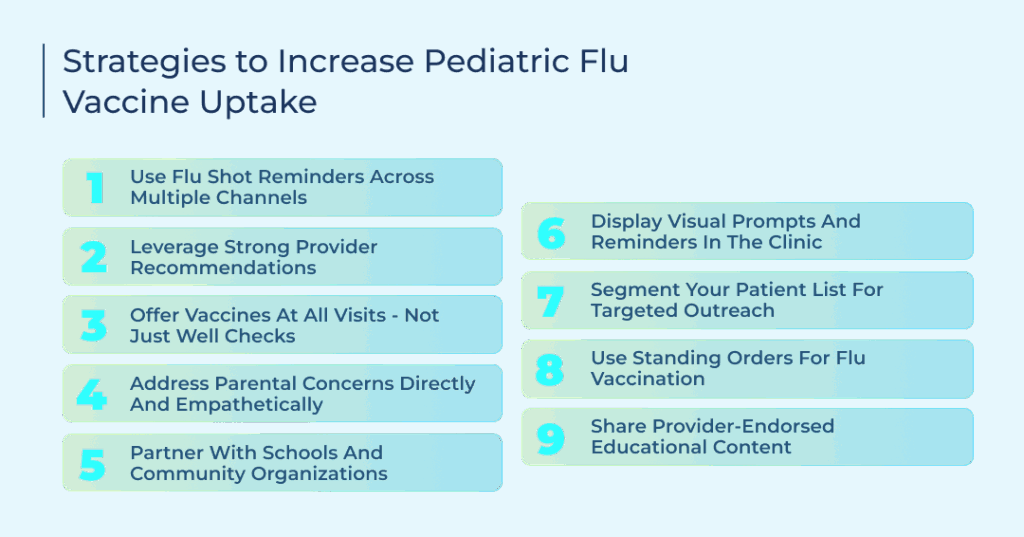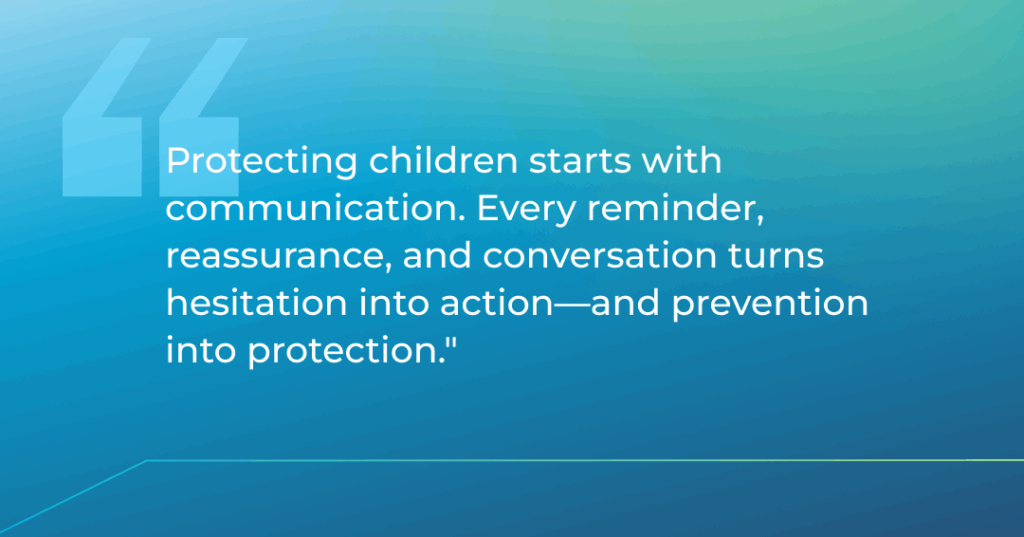When patients miss their vaccinations, it leaves both them and their communities exposed to preventable…

How to Boost Pediatric Flu Vaccine Uptake as a Healthcare Provider
Last flu season claimed the lives of more than 200 children in the United States, the highest toll in over a decade. And yet, at the same time, millions of kids went without protection.
Understand that healthcare providers aren’t just vaccinators. They’re translators, counselors, and trusted voices. That means proactive communication matters, and tools like patient portals, appointment reminders, short explainer videos, and clinician-authored messages are the road to improved vaccination numbers.
In this guide, we’ll look at practical ways to raise pediatric flu vaccination rates by combining evidence-based communication with everyday digital tools.
The Current State of Pediatric Flu Vaccination
Getting children vaccinated against the flu is more difficult than it should be. The 2024-2025 flu season saw only 49.2% of children get their flu shot. That’s barely half. The previous season wasn’t much better, with a rate of 55.4% for children aged 6 months to 17 years.
The American Academy of Pediatrics keeps pointing out that fewer than half of eligible children in the US are getting their shots, leading to more hospitalizations, and sadly, more flu-related deaths.
These numbers tell a grim story, but they also present opportunities for healthcare providers to step in and increase pediatric flu vaccination rates, thereby keeping vulnerable children safe from something that can be prevented.
Barriers to Improved Vaccine Uptake
Healthcare professionals face a combination of parental fears, system issues, and communication breakdown when trying to up-tick their vaccination rates.
- Some parents have hesitations about flu vaccines. They fear safety issues, wonder if their child actually needs it, or they’ve heard misinformation, which prompts them to avoid flu shots.
- The preventive care gap further widens when doctors and nurses lack confidence in their communication or fail to directly address parents’ questions.
- Flu shot reminder systems sound great in theory, but fall short in practice. Healthcare providers struggle to keep immunization records up-to-date, and with that, outdated contact details make it difficult to reach many families.
- Basic access issues often get in the way. Parents can’t always find timely appointments, and some families struggle to reach healthcare services at all.
Strategies to Increase Pediatric Flu Vaccine Uptake
Healthcare providers are trying different approaches to improve the rate of pediatric flu vaccine uptake in their communities. Research shows, as we will discuss below, these strategies work best when you combine them instead of cherry-picking one and hoping for the best.

1. Use Flu Shot Reminders Across Multiple Channels
Your flu shot reminders are only effective if parents see them. But that doesn’t mean you should start spamming them in the hopes they see one of them. The better approach is to send reminders via their preferred (or multiple) channels. This increases immunization rates by 5-20% in many cases.
This also increases your manual workload, which is why most EHR systems use automated reminders while staying HIPAA compliant. It saves you time and effort, and covers more ground at scale.
2. Leverage Strong Provider Recommendations
Be firm and direct in your tone, and steer clear of questions such as “Would you like to have the flu shot for your child?” because that simply invites parents to say no. Even if they do not, they will begin wondering. “How about we get your child the flu shot today?” works so much better.
3. Offer Vaccines at All Visits – Not Just Well Checks
Flu shots are not limited to just well-child visits. So train your team to think about vaccines every time a child walks through the door. This can be done automatically as well, with the system flagging a patient for a due vaccine no matter their appointment type. Utilizing every visit is known to potentially raise vaccination rates in young children by 20%.
4. Address Parental Concerns Directly and Empathetically
Parents always have concerns, and dismissing them doesn’t help anyone. The usual worries are about whether the vaccine is safe and if their kid even needs it. Listen first, acknowledge their concern, then give them straight information.
For safety worries, try something along these lines: “I get your concern. For most kids, the only side effect is a sore arm that lasts a day or two. Serious reactions are very rare, much less likely than ending up sick from the flu.”
For the “my kid is healthy” argument, try noting what happens if they don’t get the shot: “Even healthy kids can get really sick from flu and sometimes need hospital care. The flu shot protects your child and also helps keep babies and grandparents safe.”
5. Partner With Schools and Community Organizations
School-based programs are great for targeting children who don’t regularly visit their doctors. Start by collaborating with school nurses to identify unimmunized children and organize clinics within the school. Then expand to after-school sports leagues, after-school programs, and community centers as good locations to target families.
6. Display Visual Prompts and Reminders in the Clinic
Put up signs and reminders where people look. Digital screens in waiting areas, posters in exam rooms, and little reminder cards that providers can carry all help keep flu shots on everyone’s mind.
Keep displays current and simple. “Flu shots available today” or “Ask about flu protection” work better than walls covered in outdated flyers. A few well-placed, current reminders beat comprehensive displays that people tune out.
7. Segment Your Patient List for Targeted Outreach
Most EHRs let you sort patients by age, their last vaccination, health conditions, and other vaccine history. Use that to send messages targeted to each patient segment.
For example, focus on early reminders for high-risk children, educational content for new families, and careful check-ins with families who refused before.
8. Use Standing Orders for Flu Vaccination
Standing orders remove the most common administrative barriers. They give the medical staff the power to administer vaccines without waiting for a physician to specifically order each one. This also ensures shorter wait times as a bonus for campaigns running in tight spaces.
9. Share Provider-Endorsed Educational Content
Most parents won’t sit down to read long documents, but they will pay attention if the content is brief and addresses their real concerns. It also helps if the information comes directly from their child’s care team. Hence, short videos with the provider’s name, branded FAQ sheets, and emails signed by the pediatrician all help build trust and credibility.
Boosting Flu Vaccine Rates With Patient Engagement Technology
Modern communication systems help your practice reach more families and track vaccination progress without manual work. Reminders and automated outreach tools have proven highly effective in this regard. Here are some key capabilities you need to increase pediatric flu vaccination rates:
- Multi-channel messaging: Send reminders through text, email, postcards, and phone calls through a single platform. Email reminders in particular have shown success in improving flu shot rates.
- Automated appointment scheduling: When families get a flu shot reminder, they can click a link and schedule right away. No need to call during business hours or wait on hold. The system shows open slots and confirms the appointment automatically.
- EHR integration: Health systems have successfully integrated vaccine scheduling systems within two weeks to help patients schedule vaccinations and assist clinicians with administration. This tracks which children received vaccines and stops reminders automatically.
- Performance analytics: Track flu shot reminder response rates and identify families who need follow-up contact. Reports show which communication methods work best for different patient groups and help staff focus outreach efforts.
- Multi-language support: This matters for patient engagement in communities where English isn’t the first language. Parents are more likely to respond when they fully understand the message.
Streamline Your Flu Vaccine Campaigns With TeleVox
Imagine launching a flu outreach campaign that almost runs itself. Parents get a message, many respond, and appointments fill without endless phone calls or spreadsheets.
Your reminders are also not going out at random. They are sent exactly to the families who need them.
While all that may sound complex, it’s made simple with TeleVox. We have the platforms and tools to give your team a faster, smarter way to keep vaccination rates up.
With our award-winning Practice Edition, you can set up seasonal flu-shot campaigns using built-in templates and let the system handle the follow-ups.
We have also recently rolled out a Planned Outreach Program that lets you schedule campaigns for the year, pick target patient lists, and automate reminders across SMS, IVR, and email.
TeleVox also offers postcards with QR codes that sit in patients’ mailboxes and provide an instant way to schedule appointments. Combined with real-time analytics, you can track which postcards are scanned and driving bookings, giving your team clear insight into campaign performance across all channels.
Forget cold calling. Those who reply are routed straight to a central request page, so your staff only handles warm leads.
Real-time analytics further sweeten the pot for your campaigns. Our tools show you which messages perform best and which need improvement. You can make quick adjustments mid-season to continue growing your vaccination turnouts.
Ready to see how it works in your practice? Schedule a demo today and get access to our flu-shot templates. Then pick one campaign, load in your eligible patient list, and let TeleVox engage families for you.




